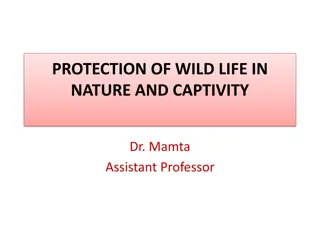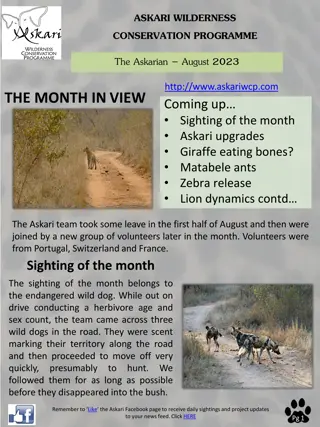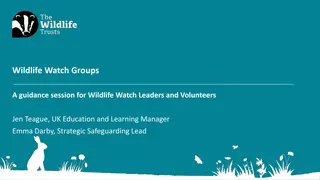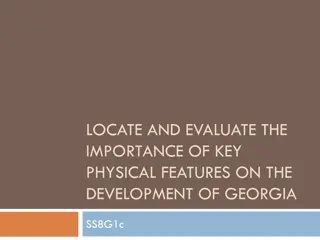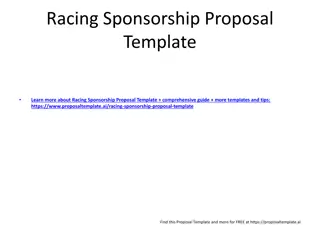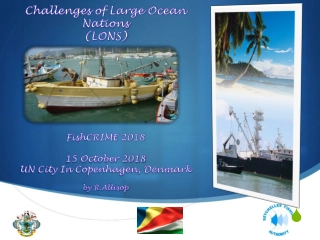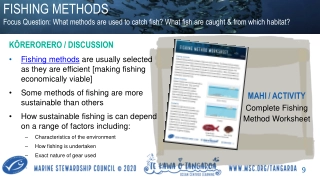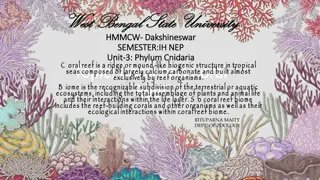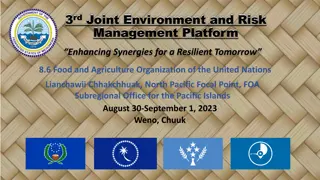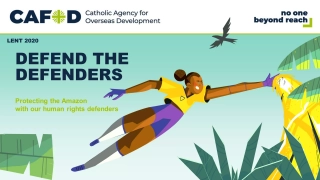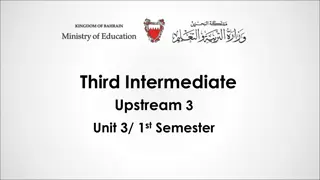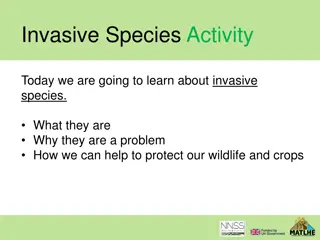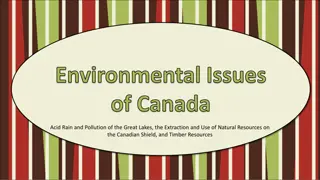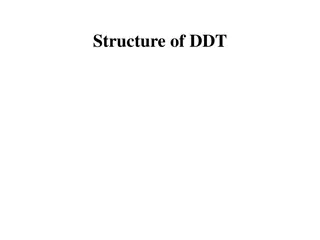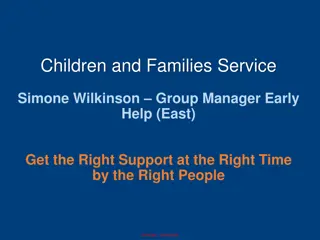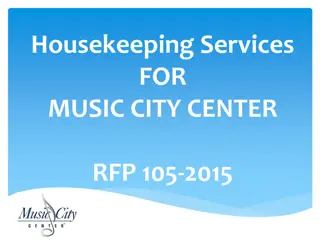U.S. Fish & Wildlife Service Overview
The U.S. Fish and Wildlife Service (FWS) is dedicated to conserving, protecting, and enhancing fish, wildlife, plants, and habitats for the benefit of the American people. They enforce wildlife laws, manage endangered species, operate hatcheries, communicate conservation priorities, and more. The FWS focuses on conservation, science, and stewardship to achieve its mission and vision.
Download Presentation
Please find below an Image/Link to download the presentation.
The content on the website is provided AS IS for your information and personal use only. It may not be sold, licensed, or shared on other websites without obtaining consent from the author. Download presentation by click this link. If you encounter any issues during the download, it is possible that the publisher has removed the file from their server.
Presentation Transcript
FWS Safety and Health March 13, 2024
Overview Mission/Vision Facts about FWS FWS Focus FWS Programs Emergency Response
Fish and Wildlife Service (FWS) Mission: The mission of the U.S. Fish and Wildlife Service is working with others to conserve, protect, and enhance fish, wildlife, plants, and their habitats for the continuing benefit of the American people. Our Vision: We will continue to be a leader and trusted partner in fish and wildlife conservation, known for our scientific excellence, stewardship of lands and natural resources, dedicated professionals, and commitment to public service.
Enforcing federal wildlife laws; Protecting endangered species with 86 field stations across all 50 states; Managing migratory birds and administering the Duck Stamp program; Restoring nationally significant fisheries and operating over 70 National Fish Hatcheries and 65 fishery resource offices; Striving to Meet the Mission Administering a national network of lands and waters through the National Wildlife Refuge System of 560 refuges and 38 wetland management districts; Advancing excellence in science and its application to conservation decision-making at landscape scales; Communicatingour conservation priorities, news, and stories to the public, media, Congress, Tribes, partners, and others; Helping foreign governments with their international conservation efforts; Distributing hundreds of millions of dollars in excise taxes on fishing and hunting equipment through the Office of Conservation Investment program to State fish and wildlife agencies
Facts about FWS 2,362 8,875 19,000 US and foreign species protected under the ESA People working at Fish and Wildlife Service Volunteersat FWS
Office of Law Enforcement (OLE/LE) OLE are composed of special agents, wildlife inspectors, intelligence analysts, forensic scientists, information technology specialists, and support staff who investigate wildlife crimes, regulate the wildlife trade, help the public understand and obey wildlife protections laws, and work in partnership with international, federal, state, local, and Tribal counterparts to conserve wildlife resources.
National Wildlife Refuges The Service manages public lands and waters called the National Wildlife Refuge System. With more than 560 refuges spanning the country, this system protects iconic species and provides some of the best wildlife viewing opportunities on Earth. The Refuge System deploys a host of scientifically sound management tools to address biological challenges. These tools, which range from active water management to wilderness character monitoring, all are aimed at ensuring a balanced conservation approach that enables wildlife and people to thrive.
The National Fish Hatchery System raises and stocks over 98 million aquatic species every year to support recreational fishing, Tribal subsistence fisheries, and the recovery and restoration of imperiled species. National fish hatcheries across the country work with states and Tribes to produce and distribute fish for recreational and conservation purposes and provide refuge for endangered species. Every year we raise approximately 73 fish species like walleye, pallid sturgeon, brown trout, and Atlantic salmon.
Emergency Response Safety and Health supports the FWS emergency management efforts by providing expertise in the safety and health as needed by the service Emergency Management staff, regional leaders, and incident command teams.
Emergency Response Safety Operations has the lead within FWS for protecting employees during emergency response operations. Safety also coordinates with the Geographic Emergency Management and Physical Security Managers (GEMPS). The GEMPs are in East, West and Central.
Emergency Response General responsibilities include: Educating employees about preparedness Ensuring the FWS employees are accounted for following an event Keeping impacted employees and supervisors informed of ongoing preparedness and response efforts Informing leadership of response efforts and employee status Working with response teams ensure safe operations
Types of Emergency Response Reponses specific to FWS: (Not always FEMA ordered/internal to FWS) Most agency types of responses: Earthquakes Floods Hurricanes Oil Spills Snowstorms Tornados Volcanoes Zoonotic Diseases Mortality Event Response Algal Blooms Chronic Wasting Wildland Fires Wildlife Welfare Emergencies Manatees Bison Health
Regional Directors sends memo guidance in establishing annual All-Hazard Disaster Plans (AHDP) review, updates, and submission to deal with major emergencies/disasters impacting Service assets that include Continuity of Operations Plan (COOP) and Mutual Aid template as well as employee assistance guidance. Before a Response Geographical Emergency Managers support regional effort for monitoring and implementing response plans for All-Hazards to include weather events.
Before/During the Response In the event of tropical weather, emergencies/disasters impacting Service assets: Regional Emergency Coordinators schedule general planning and response meetings with GEMPS, Programs Area Leads (PALs) and other keys personnel. Stations implement All Hazards Deployment Plans (AHDP) to include employee status reporting. FEMA/FWS leadership will appoint the Incident Commander and Incident Management Team (levels vary: Type 1-Type 5) FWS will make the determination for mobilizing of Special Operations Response Team (SORT) (if applicable) for employee accountability and initial damage assessment.
Before/During the Response Stations in affected area after storm/event clears conduct employee accountability and damage assessment and request assistance as needed. This can be mutual aid from neighboring assets or from IMT mobilized taskforces. Regional Emergency Coordinator and GEMPS maintain coordination and communication with FEMA and state agencies in accordance with National Incident Management System (NIMS) for any Emergency Support Functions (ESFs), which consist of federally grouped resources and capabilities into functional areas most frequently needed in a national response. Daily operational meeting and status updates.
After/Recovery of the Response Once the stations and areas are out of immediate threat and stabilizing efforts completed, IMT elements are demobilized. Implement National Disaster Recovery Framework (NDRF) for restorative efforts not only for the physical station but for Service employees. After-action reports and meetings.
Pre/Post Response FWS Staff FWS Staff and Family Evacuation travel allowances Administrative leave Assist with immediate needs post response
Chainsaw crews Emergency Response Teams and Resources Heavy Equipment Task Force Law Enforcement Surge Team Watercraft Strike Team Response Trailers
Endangered Species Manatee Rescue Environmental Response The response had three missions that were carried out daily. 1. Provisioning (feeding) FWS involved. 2. Recovery (carcasses then necropsies) 3. Rescue (boat; net then some are transported by box truck to care facilities
The Puerto Rican parrot recovery program is an effort to conserve, protect and manage wild and captive parrots in order to downlist the species from endangered to threatened.
Hurricane Maria made landfall on Puerto Rico as a Category 4 storm on September 20, 2017. At the time of landfall Maria was the fifth strongest hurricane to hit the U.S.
Hurricane Response J. N. "Ding" Darling National Wildlife Refuge in Sanibel Island, Florida was hit with a devastating blow when Hurricane Ian swept through on September 28, 2022. Safety Operations deployed in support of Hurricane Ian Response Team to Florida, provided safety and health oversight to 35+ responders, removed debris/branches and assisted the community in need and secured critical FWS assets.
Interagency Fire and Fire Aviation Operations Fish and Wildlife Service, Indian Affairs, Forrest Service, Bureau of Land Management and National Park Service
Branch of Fire Management Service s Fire Management Program is part of the National Wildlife Refuge System. Since the 1930 s, the Service has utilized fire to maintain healthy ecosystems and lower the risk of catastrophic wildfire. The program also provides mutual aid to other federal, state and local fire management agencies and is a member of the National Wildfire Coordinating Group (NWCG). What We Do Fire management is essential to the FWS, with more than 80 percent of refuge lands being fire-adapted ecosystems comprised of healthy wildlife habitat that depend on periodic fire. The FWS fire program is responsible for protecting more land management units than any other federal agency, with more than 75 million burnable acres. The FWS Service s fire management program has three main areas of focus: fuels management, wildfire management, and wildfire prevention. Wildfire management demands technical expertise in firefighting and prescribed burning, an understanding of fire ecology, and public education.
Midway Atoll NWR Midway Atoll National Wildlife Refuge and Battle of Midway National Memorial directly supports airfield operations and conservation management of the refuge. FWS staff can render aid and provide support. Halfway between the continental western U.S. and Asia, and is approximately 1,200 miles NW of Honolulu, Hawaii, in the Pacific Ocean. Henderson Field is a public airport located on Sand Island in Midway Atoll, an unincorporated territory of the United States. The airport is used as an emergency diversion point for ETOPS operations.
Snow Roof Load Roof has approximately 30 psf of snow load in the two areas. Weight of the ice still needs to be added into the that calculation. Observed damaged truss connections/gusset plates in a few areas of the original 1976 building.
Damage consisted of the following: Truss plates that were not totally seated during installation. Cracked 2x6 top cord members. Truss plates installed in the lower of the top cord at the end of the truss near the top cord bearing point. Snow Roof Load Roof needs to be shoveled. Snow load is recommended to be kept below 15psf until the trusses are evaluated. All Service employees will not occupy the building due to the potential hazard associated with the roof s trusses.
Deepwater Horizon/Oil Spill Response Gulf of Mexico is one of the world's most ecologically rich areas and provides habitat for a great diversity of fish, birds, mammals, reptiles and other wildlife. Many species of wildlife, including some that are threatened or endangered, live along the Gulf Coast and have been affected by the oil spill. DOI and its bureaus have responsibility for a spectrum of natural resources in the Gulf that will be impacted by the oil spill, including National Wildlife Refuges, National Park units, migratory birds, and threatened and endangered species, such as manatees, and sea turtles. The Department manages 36 national wildlife refuges and eight national park units along the Gulf Coast from Texas to Florida's peninsula that cover nearly three million acres of pristine freshwater, tidal and terrestrial habitats. There are 38 federally-listed species protected under the Endangered Species Act along the Gulf Coast for which the Service and National Oceanic and Atmospheric Administration (NOAA) Fisheries are concerned about relative to this spill, and 29 of those are endangered.
Deepwater Horizon/Oil Spill Response Approximately 1,000 miles of shoreline have been impacted, affecting approximately 275 miles of Department of the Interior lands is experiencing moderate to heavy oil impacts. Nearly 500 miles of shoreline is experiencing light to trace oil impacts in Louisiana, Mississippi, Alabama, and Florida. To give you a sense of the ecological value of these coastal habitats, consider that the northern Gulf Coast is home to one of every four Laughing Gulls. Nearly half of the southeastern population of Brown Pelicans lives along the northern Gulf Coast and generally nests on protected coastal islands. The Brown Pelican was taken off the endangered species list along the Gulf Coast prior to the oil spill. More than 35 percent of the southeastern populations of Royal Terns and Least Terns rely on northern Gulf Coast habitats as well. The impacts so far have been significant.
Deepwater Horizon/Oil Spill Response FWS R4 Spill Strike Team at full activation within 96 hours. There were over 3,447 FWS responders throughout the response. Examples of field operations directly involving FWS, NPS, and USGS staff included: Helped deploy and maintain almost 2 million feet of containment boom, with the goal of protecting the most sensitive areas. Engaging in multiple over flights to survey for birds, manatees and other wildlife along the coasts. Conducting Natural Resource Damage pre/during/post assessments and conducting beach surveys to monitor sea turtle nests and developed protocols for cleanup crews
Deepwater Horizon/Oil Spill Response Continued in 2024 The Service has a responsibility to the public, including our partners, to ensure meaningful conservation outcomes for our shared fish and wildlife goals. While the conservation needs of the Gulf of Mexico are daunting, collectively FWS has the potential to significantly advance Gulf restoration and provide ecological and economic benefits to the American public. Restore and conserve habitat Restore water quality Replenish and protect living coastal and marine species Enhance community resilience Restore and revitalize the Gulf economy












